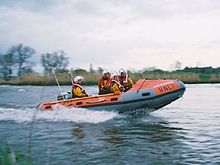D-class lifeboat (EA16)

D-class lifeboat at speed
|
|
| Class overview | |
|---|---|
| Name: | D-class (EA16) |
| Builders: | Avon Inflatables |
| Operators: |
|
| Preceded by: | D-class (Zodiac III) |
| Succeeded by: | D-class (IB1) |
| Built: | 1987–2002 |
| In service: | 1987–2010 |
| Completed: | 243 |
| General characteristics | |
| Class and type: | Evans Avon 16 |
| Displacement: | 338 kg (745 lb) |
| Length: | 4.9 m (16 ft) |
| Beam: | 2 m (6.6 ft) |
| Propulsion: | 1 × 40 hp Mariner outboard engine |
| Speed: | 20 knots (23 mph) |
| Endurance: | 3 hours at full speed |
| Complement: | 3 or 4 |
The D-class (EA16) lifeboat are a class of inflatable boat operated since 1987 by the Royal National Lifeboat Institution of the United Kingdom and Ireland. It has been replaced operationally by the D-class (IB1), but many are still used as part of the relief fleet, as boarding boats for the larger classes of lifeboat and by the RNLI Flood Rescue Team.
The type designator EA16 stands for Evans Avon 16.
For more than 40 years the D-class served as the workhorse of the RNLI Inshore Lifeboat (ILB) fleet. Significantly smaller in comparison to the rest of the inshore fleet, the D-class is also one of the few RNLI types not to feature a rigid hull. The main aspect of the boat would be both its size and weight - only 436 kg (961 lb). The D-class was specifically designed as a light and highly manoeuvrable rapid response craft.
The D-class lifeboat consists of two sponsons, together housing seven inflatable segments intersected by baffles. The main construction fabric is Hypalon-coated Nylon which provides a durable, non-tear surface.
This was one of the smaller classes of lifeboat operated by the RNLI, and they were a common sight at lifeboat stations around the coast. Unlike other members of the ILB fleet, the D-class does not have a rigid hull; all others, with the exception of the Arancia, hovercraft and ALB Tenders, are Rigid Inflatable Boats (RIBs).
The D-class normally had a crew of three or four and was primarily used for surfer/swimmer incidents as well as assisting in cliff incidents where the casualty was near the water. The very nature of its work required a swift response, and the D-class can normally be afloat within five minutes of the pagers going off.
...
Wikipedia
